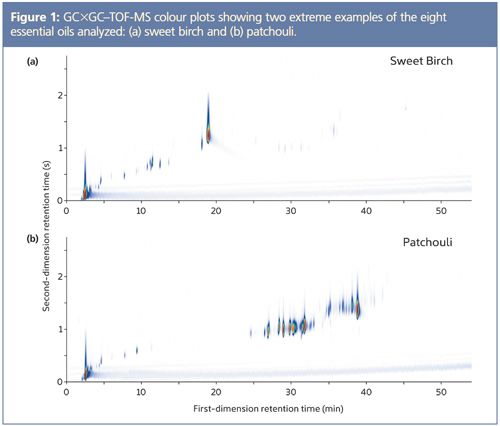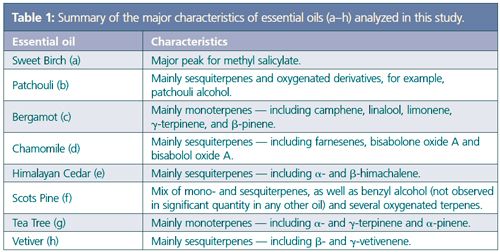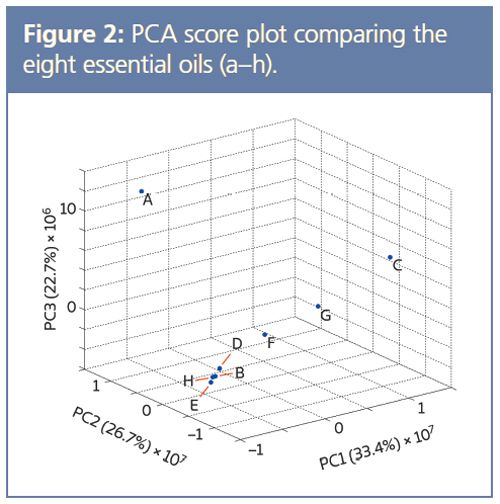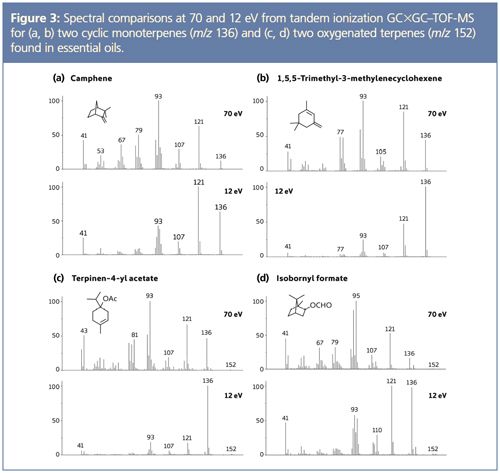Detailed Characterization of Essential Oils by Flow-Modulated GC×GC with Tandem Ionization TOF-MS
The Column
This article describes the use of comprehensive two-dimensional gas chromatography (GC×GC) with time-of-flight mass spectrometry (TOF-MS) and tandem ionization for characterization and comparison of the composition of essential oils, aiding rigorous quality control.
Photo Credit: AWEvans/Getty Images

Matthew Edwards, Laura McGregor, and David Barden, Markes International, Llantrisant, Wales, UK.
This article describes the use of comprehensive two-dimensional gas chromatography (GC×GC) with time-of-flight mass spectrometry (TOF-MS) and tandem ionization for characterization and comparison of the composition of essential oils, aiding rigorous quality control.
Quality Control of Essential Oils
Volatile oils of plants, also known as essential oils, have been used for many years for their flavour, fragrance, and medicinal properties. However, their extreme complexity and diversity presents analysts with a significant challenge when it comes to quality control. They are generally composed of monoterpenes and sesquiterpenes, as well as their oxygenated derivatives, such as aliphatic aldehydes, alcohols, and esters (1).
In many cases, trace components can impart a distinctive fragrance character to the oil, meaning that rigorous quality control procedures are required to ensure that essential oils do not vary significantly from the initial reference batch, or contain any unwanted adulterants. Furthermore, because essential oils are raw materials for the perfume and cosmetics industries, analysts must now also ensure that they adhere to legislation on fragrance allergens, such as the EU Directive on cosmetic products (2).
Modulation Options for GC×GC Analysis of Essential Oils
Traditionally, one-dimensional gas chromatography coupled with mass spectrometry (GC–MS) has been the standard method for qualitative and quantitative analysis of essential oils, with analysts relying on the combination of retention indices and mass spectra to confirm the identity of individual terpenes.
However, comprehensive twoâdimensional GC (GC×GC) has in recent years become an attractive technique for characterization of essential oils, with one of the earliest examples a report by Dimandja et al. in 2000 on the analysis of peppermint and spearmint oils (3). Such analyses typically employ timeâofâflight MS (GC×GC–TOF-MS) (4), with a recent review of essential oil analysis (5) pointing out the very highâresolution separations and full-range mass spectra available using this method, which ultimately result in improved analyte identification.
The key component in any GC×GC system is the modulator - the device that samples and re-injects the firstâcolumn effluent on to the second column in narrow bands to ensure that the firstâdimension separation is retained and that the short second-dimension column does not become overloaded. Thermal modulation is the most commonly used technique, but this often requires expensive liquid cryogen and can make it difficult to achieve precise replication of results across multiple instruments. An alternative approach is flow modulation, which avoids the inconvenience and expense of liquid cryogen, and offers much better between-sample and between-instrument repeatability (6).
This study investigates the application of flow-modulated GC×GC–MS to enhance the separation of essential oils. The modulator used allows separation of volatiles ranging from C1 to C40 (and above), the flexibility to change the loop volume in method optimization, and additional options including heartâcutting, splitting for parallel detection, and backflushing. In addition, we show how the data generated can be processed using multivariate statistical analysis, for fast evaluation of compositional differences.
Soft Electron Ionization for Improved Isomer Speciation
Even with the advances offered by modern GC×GC and the added power of retention indices in two dimensions, the similarity of many terpenes found in essential oils makes it difficult (or impossible) to achieve reliable speciation when using conventional 70 eV electron ionization.
This problem can now be addressed by the use of a soft electron ionization (EI) technique that offers the advantages of soft ionization for GC–MS, without any of its historic disadvantages - such as hardware changes, additional reagent gases, and inherent loss of sensitivity. The technique uses an ion source design in the TOF instrument that allows the ionization energy to be varied on a sliding scale from conventional 70 eV to lower energies (7).
The physical properties of most small molecules means that relatively small differences in ionization energies between 10 eV and 20 eV can have significant differences in the fragmentation pattern. Typically, however, an ionization energy of about 12–14 eV retains a useful degree of fragmentation while avoiding a loss in sensitivity relating to the unavoidable drop-off in ionization efficiency as the ionization potential is approached.
This soft EI technique has already been applied to analytes including petrochemical hydrocarbons (8), emerging environmental contaminants (9), and allergens in cosmetics (10), and this article illustrates its application to essential oils, with a focus on the monoterpenes and sesquiterpenes. These are challenging because extensive fragmentation at 70 eV can make speciation difficult, especially in complex matrices. Using soft ionization provides enhanced “diagnostic” ions and reduced chemical noise leading to lower detection limits, as well as simplified spectra for more confident qualification. A further boost in sensitivity is gained by reduced ionization of common background or carrier gases at low ionization energies, leading to minimal chemical noise and improved signal-to-noise ratios for compounds of interest.
In this article, the efficiency of the analysis of a range of essential oils by flowâmodulated GC×GC–TOFâMS is further enhanced by use of the “tandem ionization” mode of the mass spectrometer. This mode uses rapid switching between hard and soft ionization energies to simultaneously generate two sets of mass spectra. In this way, a single chromatographic dataâset can be used to generate both 70 eV mass spectra for regular library-matching and soft-EI spectra for improved isomer speciation.
Experimental
Sample Preparation: 1% (v/v) dilutions of eight essential oils were prepared in ethyl acetate.
Instrumental: GC×GC: Injector: Split/splitless. Liner: Single taper with wool, 4 mm (i.d.). Carrier gas: Helium, constantâflow at 0.6 mL/min. Mode: Split 100:1. Temperature: 280 °C. Septum purge: On, 1 mL/min. 2D column set: 1st dimension: 20 m × 0.18 mm, 0.18âµm BPX5 (SGE Analytical Science [Trajan Scientific]). 2nd dimension: 2 m × 0.25 mm, 0.15-μm DB1701 (Agilent Corporation). Temperature program: Main oven: 40 °C (1 min), 3 °C/min to 260 °C, 10 °C/min to 280 °C (10 min). Flow modulator: Insight (SepSolve Analytical). Loop dimensions: 0.53 mm i.d. × 230 mm (loop volume: 50 µL). Fill time: 3600 ms. Flush time: 200 ms. Modulation period (PM): 3.8 s.
TOF-MS: Instrument: BenchTOF-Select (Markes International). Filament voltage: 1.7 V. Ion source: 300 °C. Transfer line: 280 °C. Mass range: m/z 45–400. Data rate: 100 Hz in tandem ionization mode at 70 eV and 12 eV.
Software: Instrument control and data acquisition: TOF-DS (Markes International). Image processing: GC Image (GC Image, LLC). Statistical analysis: MATLAB (R2011a, MathWorks).
Results and Discussion
Screening of Essential Oils: The GC×GC–TOF-MS colour plots for the eight essential oils (a–h) display dramatic differences in monoterpene and seqsuiterpene content - two examples are shown in Figure 1. Sweet birch (a) almost entirely comprises monoterpenes (firstâdimension retention time, RT1 = 8–22 min), while patchouli (b) mostly contains sesquiterpenes (RT1 >22 min). A summary of the main characteristics of each oil is provided in Table 1.


The flow-modulated GC×GC–TOF-MS method effectively separated multiple chemical classes that would co-elute in a one-dimensional separation. It is useful to have retention times in both dimensions, as well as mass spectra for confirming compound identity. This is even more important when investigating final fragrance mixtures or cosmetics, which contain higher matrix levels that can hinder identifications in a 1D separation.
Fast Comparisons of Composition: A template of over 100 different target compounds was prepared and applied to each sample, in order to collate the peak area data (using EIC chromatograms for a specified quant ion for each target). Principal components analysis (PCA) was then applied to the peak lists to distil the information into the key differences in sample composition. It is worth pointing out that the high repeatability of RT1 and RT2 using flow modulation is the result of a dedicated EPC (electronic pressure control) module for each column. This makes flow modulation well-suited to large-scale projects and comparisons across multiple data sets, because of the minimal retention-time differences for any given peak.
The PCA score plot (Figure 2) shows that chamomile (b), Himalayan cedar (c), patchouli (d), and vetiver (h) all cluster closely, while the other oils are spread out across the plot. The first three principal components described 82.8% of the sample variation. The major contributors to PC1 are terpinen 4-ol and α-terpinene, while for PC2 they are monoterpenes including linalool, limonene, linalyl acetate, and β-pinene. Finally, methyl salicylate contributes most to the variation on PC3, explaining why sweet birch (f, which has a high content of this compound) is separated from the other oils on this axis.

This type of GC×GC–TOF-MS screening approach, coupled with automated template-based compound identification, can allow differences in target compounds across multiple essential oil batches to be determined quickly and effectively in a quality control laboratory.
Tandem Ionization for Confident Identification of Terpenes: The screening approach described works well in cases where target compounds are known and have distinctive mass spectra - for confident identification using automated templates. However, in many situations characterization of the entire sample is required to provide the final fragrance formulation, including “unknown” compounds that may not be present in spectral libraries.
This is a challenging prospect when the dominant constituents are terpenes with very similar EI (70 eV) mass spectra, which are consequently difficult to speciate confidently. Tandem ionization is of great value in such cases, because it allows two complementary datasets to be acquired simultaneously without impacting laboratory workflow, and with perfectly aligned peaks for easy navigation of the soft EI data.
Figure 3 provides spectral comparisons of two sets of terpenes. The 70 eV spectra within each pair are similar to each other, with identical ions present for each compound and in comparable ratios, making it difficult to identify the individual compounds. The 12 eV spectra, however, have distinct differences, meaning that the use of a library of 12 eV spectra (11) can add confidence to essential oil characterization.

Conclusions
In this article, we have shown that the use of flow-modulated GC×GC with TOFâMS detection can be successfully applied for routine and repeatable screening of essential oils. This approach ensures that confident identification is achieved for these complex mixtures - which is particularly important for quality control within the fragrance industry.
The ability of GC×GC–TOF-MS to provide structured chromatograms, with chemical classes eluting in bands, can aid data review, enabling swift tentative identifications to be made. The use of tandem ionization then adds an additional level of confidence in situations where 70 eV data alone cannot speciate similar terpenes, but without the inherent loss in sensitivity previously associated with soft EI, and with the ability to provide independent ion ratio checks at both 70 eV and low eV.
From an operational perspective, tandem ionization avoids the inconvenience of ion-source changes and reagent gases commonly required for chemical ionization, the most commonly used soft ionization technique. Moreover, because two datasets are acquired simultaneously (in a process analogous to “SIM/scan” mode in quadrupole MS), it also adds no extra time to the process of data acquisition, meaning that it can be easily integrated into existing workflows.
References
- B. d’Acampora Zellner, P. Dugo, G. Dugo, and L. Mondello, in Handbook of Essential Oils: Science, Technology and Applications, K.H.C. Baser and G. Buchbauer, Eds. (CRC Press, 2nd ed., 2015), pp. 195–225.
- Directive 2003/15/EC of the European Parliament and of the Council of 27 February 2003 amending Council Directive 76/768/EEC on the approximation of the laws of the Member States relating to cosmetic products, http://eur-lex.europa.eu/legal-content/EN/TXT/?uri=celex%3A32003L0015
- J.-M.D. Dimandja, S.B. Stanfill, J. Grainger, and D.G. Patterson, Journal of High-Resolution Chromatography23, 208–214 (2000).
- R.A. Shellie, in Comprehensive Two Dimensional Gas Chromatography, L. Ramos, Ed. (Elsevier, 2009), pp. 189–213.
- A. Smelcerovic, A. Djordjevic, J. Lazarevic, and G. Stojanovic, Current Analytical Chemistry9, 61–70 (2013).
- M. Edwards, A. Mostafa, and T. Górecki, Analytical and Bioanalytical Chemistry 401, 2335–2349 (2011).
- L. McGregor, N. Bukowski and D. Barden, Current Trends in Mass Spectrometry, supplement to LCGC North America, LCGC Europe, and Spectroscopy 12(1), 16–19 (2014).
- L. McGregor and D. Barden, Hydrocarbon Engineering July 2014, http://www.energyglobal.com/downstream/gas-processing/31072014/Crude-oil-markes-analysis/
- L. McGregor, A. Gravell, I. Allan, G. Mills, D. Barden, N. Bukowski, and S. Smith, The Analytical Scientist April 2015.
- S. Smith, L. McGregor, and D. Barden, The Column10(3), 13–16 (2014).
- A database of low-eV electron ionization spectra is currently being developed, which should assist analysts investigating samples using this approach: Select-eV library, Markes International. Available at: http://www.markes.com/select-ev-library/
Matthew Edwards studied analytical chemistry at the University of Waterloo with particular emphasis on multidimensional separations, and will shortly be defending his Ph.D. thesis on that topic. He joined Markes in 2015 as a separation science product specialist, and is currently focused on developing and applying separation and detection technologies to complex analytical challenges.
Laura McGregor received an M.Chem. in chemistry from the University of St Andrews, UK, followed by an M.Sc. in forensic science at the University of Strathclyde, UK. Her Ph.D. in environmental forensics, also at the University of Strathclyde, focused on the chemical fingerprinting of environmental contamination using advanced techniques such as GC×GC−TOF-MS. Laura joined Markes in 2013 as a sales support specialist, and is now product marketing manager for Markes’ TOF-MS product portfolio.
David Barden is technical copywriter at Markes, having joined the company in 2011. David studied natural sciences at the University of Cambridge, UK, and remained there for his Ph.D. in synthetic organic chemistry, which he received in 2003. A placement at Wiley-VCH, Germany, was then followed by seven years as a journals editor at Royal Society of Chemistry Publishing, UK.
E-mail: enquiries@markes.com
Website:www.markes.com

Fundamentals of Benchtop GC–MS Data Analysis and Terminology
April 5th 2025In this installment, we will review the fundamental terminology and data analysis principles in benchtop GC–MS. We will compare the three modes of analysis—full scan, extracted ion chromatograms, and selected ion monitoring—and see how each is used for quantitative and quantitative analysis.
Characterizing Plant Polysaccharides Using Size-Exclusion Chromatography
April 4th 2025With green chemistry becoming more standardized, Leena Pitkänen of Aalto University analyzed how useful size-exclusion chromatography (SEC) and asymmetric flow field-flow fractionation (AF4) could be in characterizing plant polysaccharides.
This information is supplementary to the article “Accelerating Monoclonal Antibody Quality Control: The Role of LC–MS in Upstream Bioprocessing”, which was published in the May 2025 issue of Current Trends in Mass Spectrometry.










